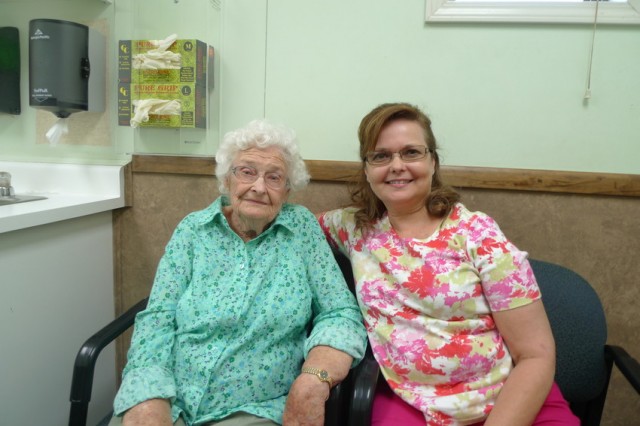Firebaugh is surrounded by crops, and the Sablans estimate that 75 percent of their patients work in the fields, like that labor contractor.
Marcia Sablan, who specializes in family medicine, explained, “He knew he could come here. He knew that we would take care of him, so be brought those 29 people over here.”
Patients have relied on the Sablans and the Sablan Medical Clinic for more than 30 years, since the couple moved to Firebaugh as young physicians in the National Health Service Corps. They say they wanted to practice where they were needed.
This long-term commitment to a community makes the Sablans an exception. Rural regions of California have long faced a shortage of doctors, and in the San Joaquin Valley, studies show the number of primary care physicians per person is about half the state’s average.
Rosie Gomez, a patient of the Sablans, said small towns nearby struggle to hang onto new doctors who come from outside the region.
“Once they’ve gained their skills, they leave and they take their skills with them,” she said of these other doctors. “They’ll practice on you, but they don’t stay.”
Bringing new doctors back home
A new program, however, is making strides to attract and retain doctors in the state's rural communities. Often, these new doctors are coming home to the neighborhoods they grew up in. Called San Joaquin Valley Program in Medical Education, or PRIME, the program selects and trains medical students to practice in the Valley. It’s a collaboration between UC Davis, UC Merced, and UCSF Fresno.
An hour away from Firebaugh in Fresno, five students medical students gather in a small exam room where a doctor teaches them how to give neurological exams. One of them is Christina Thabet, who grew up in Bakersfield. All of the students either hail from the Valley, or have ties to it.
“We’re learning on the population we want to work with in the future,” Thabet said, during a break in training. “You can see our families in the eyes of our patients because they grew up here, and kind of had the same challenges that they have in health care that our families had.”
Thabit remembers her grandfather, a dairy farmer, having a hard time getting appointments for cardiology and diabetes care. When he did, he had to drive over one hour, one way.
Most days, Thabit is training at a Fresno hospital. Once a week, she travels to a clinic in the rural town of Selma, where she sees patients while being supervised by medical faculty. Thabet said she’s working harder than she ever imagined, but she knows she chose the right program.
“The clinical experience, the education and the fact that I’m home, I mean, that’s my ideal medical school,” she said. “There was no better fit for me.”
Doctors as integral members of community
Back in Firebaugh, Dr. Marcia, as her patients call her, reviews X-rays with a woman who’s worked in cantaloupe fields for three decades. The patient has chronic laryngitis -- and no insurance. She’ll probably have to wait a long time to get an appointment at a hospital in Fresno, so Dr. Marcia searches through drug company samples for a medication that can ease her symptoms until then.
The Sablans charge a low sliding fee and negotiate the Medi-Cal labyrinth. It’s all part of a balancing act: making a living while caring for needy patients.
In another exam room, Dr. Oscar meets with 95-year-old Mareen Williams, who came to Firebaugh from Oklahoma in the 1930s and picked cotton and cut corn. Even though she moved away recently to be closer to family, she returns to the clinic to see Dr. Oscar.
“He saved my life several times,” Williams said.
She trusts Sablan with managing her complicated blood condition, and she won’t see another doctor unless he makes the referral. The Sablans' relationships go beyond the clinic: the doctors make house calls, and know their patients as neighbors.
“They’re more like folks,” Williams said. “They come to your house. I used to give a big Easter egg hunt. They came out with their children.”
The Sablans see health as more than medical care. That’s why, besides putting in long hours at the clinic, Oscar has served on Firebaugh’s school board close to 20 years, and Marcia has been on the city council over 30, working to improve housing, sewage and water systems.
“That’s been an overriding thing for me – the built environment [and] how important that is to people’s health,” she said.
Patient Rosie Gomez said she can’t picture Firebaugh without the Sablans practicing medicine, even though she knows some day it will happen. Both doctors are in their 60s.
“They’re human just like we are,” Gomez said. “They get older and they’re going to want to retire one day and I can’t blame them. But who replaces them?”
PRIME is working on this. Now in its third year, the program will continue to pick about six students for each new class. Administrators hope PRIME's success could be a stepping stone towards creating a full medical school in the Valley someday.
This won’t solve the immediate physician shortage in San Joaquin Valley and other parts of rural California, but as Gomez said, each medical student could have a real impact on a community, like Firebaugh.
